There are three inspirational sayings that could explain why sacred sanctuaries exist so far up in the mountains, built halfway between the heavens and the earth.
“When the mind is still, then truth gets her chance to be heard in the purity of the silence” could be the first. “Nothing in all creation is so like God as stillness” could well be the second, and the last is “the best view comes after the hardest climb.”
Hanging suspended in the air as if they are reaching toward God, these monasteries serve to prove that a quest for silence, serenity, and inner peace can be so great as to drive men to build unimaginable things in the most unimaginable places. Monks, priests, and devotees of different cultures and faiths climbed the hardest paths in search of “better views,” and with prayers and meditation have heard truth in the purity of silence that only a mountain can provide.
In China, Buddhists, Confucianists, and Taoists found it by meditating in silence in the gravity-defying Hanging Temple, built 250 feet up on a cliff of Mount Hengshan 1,500 years ago. Statues of Siddhartha, Confucius, and Lao Tzu enshrined together in the San Jiao Hall, one of the 40 halls and cabinets inside the temple, prove that while “silence is a source of great strength, knowing others is wisdom” (Lao Tzu) and “virtue is not left to stand alone. He who practices it will have neighbors” (Confucius).
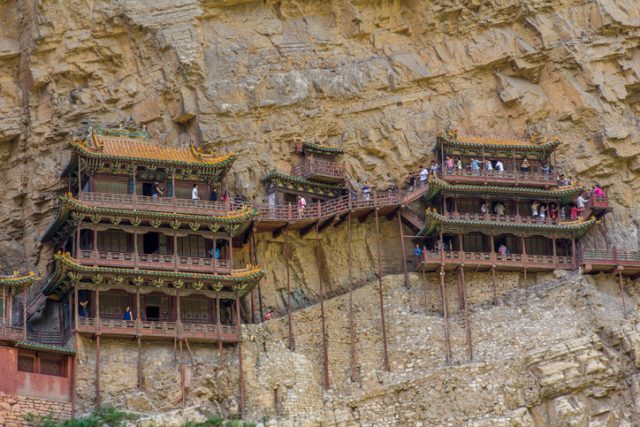
For those who prefer their retreat to be at the top of a mountain rather than clinging precariously to vertical rock, there is Taung Kalat, the Buddhist temple perched on top of a 2,000-foot-high volcanic plug in Myanmar (Burma). Those who climb the 777 steps that lead to it can enjoy breathtaking views in every direction and its 2,000 temples–in the company of mischievous macaque monkeys that live in tranquility with the local monks.
If that’s not enough, some days at sunset, hundreds of air balloons are flown from the Bagan Valley down below and fill the sky in an unforgettable dreamlike spectacle, thus making the climb even more worthwhile. Setting foot on the final step is a treat like nothing else is in the world.
Not far from China, Myanmar, and Taung Kalat’s macaque monkeys, legend has it that Padmasambhava, also known as Guru Rinpoche, arrived in the Himalayas in Bhutan on the back of a flying tigress that, before being reborn and transformed, was his concubine and disciple.
Guru Rinpoche had flown from Tibet to tame a mountain tiger demon who lived in darkness inside the caves around Paro Valley. After he succeeded and the demon was tamed, he consecrated the caves and turned them into shrines where he meditated for years, and spread Buddhism to the Bhutanese in the following decades. One of these caves, located in a towering cliff 10,000 feet above sea level and 3,000 feet from the valley floor, is the Taktsang Palphug Monastery, or the Tigers Nest. It is thought that devotees motivated to keep the legend alive built this castle in the sky in 1692.
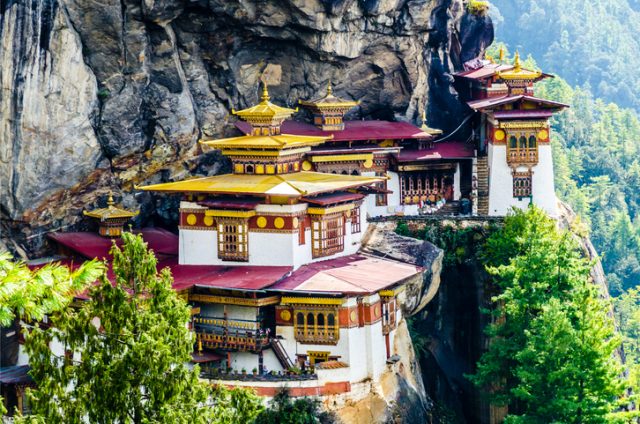
Visitors report that, due to humidity in the surrounding area, the monastery is mostly shrouded by mist or is covered by tiny clouds floating above, giving the temple an even more ethereal and surreal look. It was a favorite refuge for local monks and Buddhists, and by the looks of it, this should come as no surprise.
A scarcity of flying tigers and tigresses in the last few centuries means that monks and visitors can gain access to this gorgeous 17th century Buddhist temple solely by foot; they reach it by walking a very long and steep path up the Himalayan cliffside. On the plus side, the atmosphere is fabulous, the view over the Paro Valley scenery is gorgeous, and the many small cave-shrines that are now a part of the temple complex definitely provide the patience and strength to those who wish to reach the cliff-hanging Taktsang Palphug.
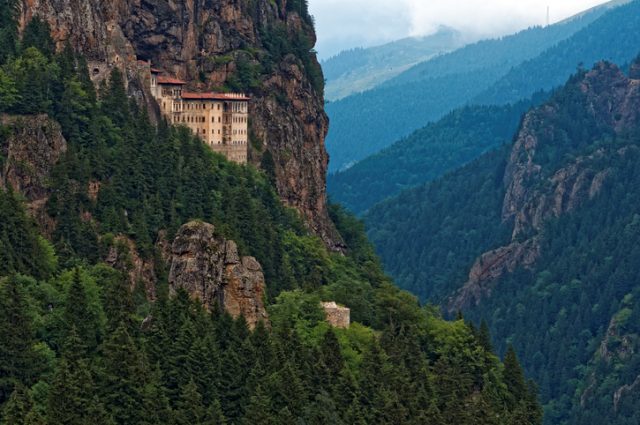
Meanwhile, in the Middle East, people walk hundreds of miles and climb non-stop for days just to reach a shrine quite literally carved into a steep towering cliff, 4,000 feet above the ground in Turkey. Excavated in the 4th century and looking like a stronghold with its facade, the Sumela Monastery was supposedly built after two monks found a mysterious icon of the Virgin Mary in one of the caves in the Altındere Valley.
Greece can be proud of its precipitously built Meteora complex of Orthodox monasteries sitting on top of a rock formation in the heart of the country in Peneas Valley, and one can only admire the courageous endeavor of those who made them. Also admirable are the commitment and the dedication of those who found the energy to get there and pray inside.
Check out a cool video showing the world’s creepiest ghost towns:
Meteora loosely translates as “suspended in the air.” Twenty-four monasteries were constructed in a space of a few decades, up in the heavens with the intention to make access difficult, if not nearly impossible. This is where the monks can be as far as possible from wars and the world of destruction down on Earth.
Unfortunately, establishments placed on top of 1,200-feet-tall sandstone pillars proved to be hard to maintain, so only six have endured the test of time. Now they stand as fine examples of how nature can be utilized as a place for retreat, meditation, and prayer without the hassle of modifying it. The Roussanou Monastery and the Holy Trinity Monastery in particular are a real treat for the soul.
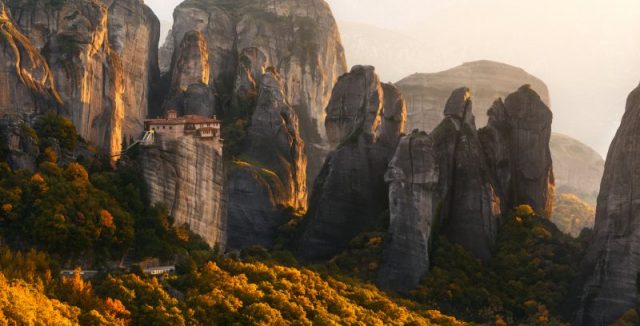
As for Italy, the country seen by many as the cradle of modern Christianity, the Renaissance, and much of the beauty of the world has more than enough sanctuaries to be proud of. Two, in particular, give true meaning to Giuseppe Verdi’s famous statement “You may have the universe if I may have Italy,” but only one of them has a legend of a pesky dragon to tell and the name of a heroic saint who defeated it.
Just outside Verona, the city of love, the Sanctuary of Madonna Della Corona hidden inside a cliff in Monte Baldo is indeed a place of silence and meditation.
But deep in the Leno Valley in the country’s far north, next to lake Lago di San Colombano, solitude is taken to a whole another level and isolation literally to new heights.
Eremo di San Colombano hangs 400 feet above the ground right in the middle of the valley’s vertical cliff face. It’s been there since the 8th century and climbing is the only way to get to it. Allegedly it was built over a cave that 14 centuries ago was a dragon’s lair. The story goes, it feasted on children who came to be baptized in the Leno River until one brave saint from Ireland got rid of the menace and made the cave sacred.
The small picturesque cliff-hanging monastery dedicated to St. Columban was built around 1319, but historians insist the cave was used as a hermitage from the 8th century.
There are 102 precarious steep steps leading up to it and each Christmas they are lit with torches that mark the path walked by pilgrims determined to pay homage to the saint who conquered evil when people needed it the most.
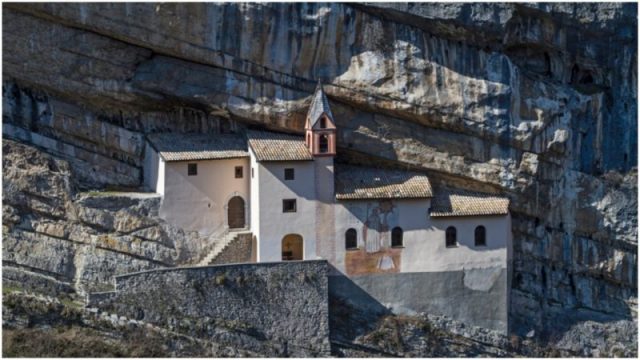
Talking about small picturesque things, there is a charming church in Georgia, a tiny one. Perhaps the smallest of all hermitages built around the world. Its whereabouts, though, are nothing less than extraordinary. Matching the size of a pigeon house and bearing a striking resemblance to the Meteora monasteries in Greece, the shrine dedicated to Maximus the Confessor sits on top of the Katskhi Pillar near the town of Chiatura in the central region of the country.
It is unclear when or how it was built on top of this 130-foot-high seemingly inaccessible pillar looking like a giant’s club. However, the site was supposedly a place of worship since the dawn of men or at least the time when humans inhabited the area.
Maxime Qavtaradze, 59, today uses it as his refuge and, according to him, “It is up here in the silence that you can feel God’s presence.”
